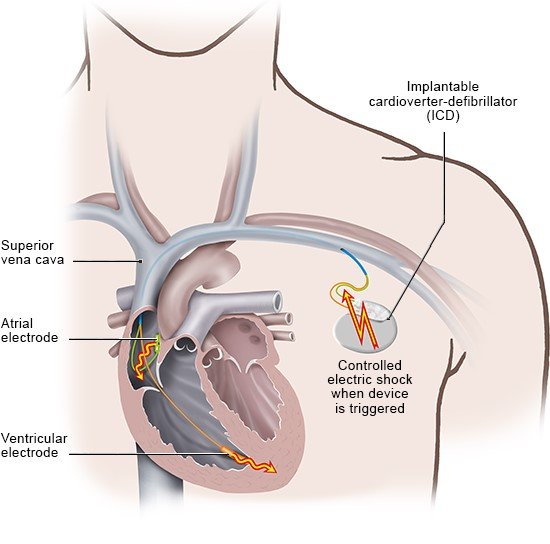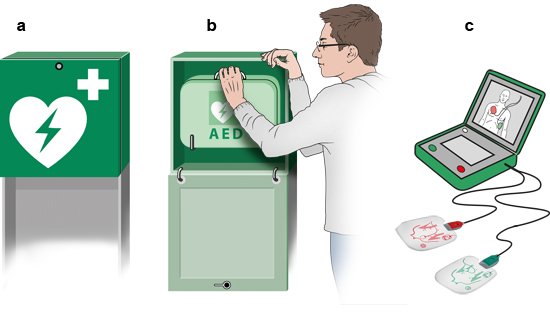A defibrillator is a device for treating heart conditions in which the heart rate suddenly gets too high. It stops the abnormal heartbeat by delivering one or several brief, controlled electric shocks to the heart as soon as it starts to beat too fast. The heart rate can then return to normal.
The process of restoring the heartbeat to its regular speed is called cardioversion. If the person had ventricular fibrillation before they were given the shock, the process is called defibrillation. That is why these devices are also known as cardioverter-defibrillators. If they can be implanted in the body, they’re called implantable cardioverter-defibrillators (ICDs).
When are ICDs needed?
A healthy heart always beats at a rate that ensures enough oxygen-rich blood can be pumped around the body. That is why it has to beat faster when you’re exercising or under stress than when you’re resting.
But people who have a serious heart disorder like heart failure or who’ve had a heart attack sometimes have trouble because their heartbeat is too fast and uncontrolled. This can have major consequences like ventricular fibrillation or sudden cardiac (heart) death. ICDs are used to prevent these kinds of complications.
What happens when you get an ICD?
If you have a very abnormal heartbeat (arrhythmia) and your heart needs permanent protection, you can have a minor procedure to implant an ICD inside your body. The ICD is a disc-shaped device, about 5 centimeters in diameter. The procedure involves inserting the device under the skin of the collarbone and stitching it into place. Sometimes the doctor will insert it under the pectoral major muscle (the large chest muscle) instead.
Most ICDs have two wires known as "leads." The surgeon threads them into a nearby blood vessel and pushes them through to the heart. The leads enable the device to constantly monitor your heartbeat. Whenever necessary, it delivers several mild or single strong brief, controlled electric shocks. Sometimes special wireless devices are used.
If your heart suddenly starts beating too fast and there’s a high risk of complications, the device can send several shocks rapidly one after another. It does this to increase the heartbeat even more so that it can return to normal when the shocks stop. This is known as overdrive pacing.
Overdrive pacing doesn’t always help. If doesn’t work for ventricular fibrillation, for instance. In these cases, the ICD delivers one strong shock to stop the heart completely for a short amount of time. This is another way of getting the heart to start beating normally again. It sometimes takes several shocks for the heart rate to return to normal.
ICDs have built-in batteries that can last up to ten years, depending on the type of device. When they run out, the ICD has to be replaced. The leads stay in the body and are reconnected to the new device.
Some ICDs can keep a record of the heart’s activity. They do this in the form of an ECG, which they store and transfer direct to the doctor’s practice.
What are the risks of using an ICD?
Complications when using an ICD are rare. The most common ones are:
- Infections
- Poor wound healing
- Bleeding, if there’s damage to blood vessels or heart tissue
- Damage to the lungs
- Leads slipping out of place
- Wear and tear on the material insulating the leads
- Malfunctioning, causing problems like unnecessary shocks
The strong shocks that the device delivers in certain situations are painful and can be frightening.
What to remember
People with an ICD can usually lead a normal life, but there are a few things you need to remember:
- Make a note of when your next check-up is. These appointments are important. Part of the check-up involves looking at the data stored in the ICD’s memory. This contains information about abnormal heartbeat, battery performance and any malfunctions. If necessary, the healthcare professional will make adjustments to the ICD settings.
- Make sure you always have your ICD card on you. One of the advantages is that the emergency services can find the information they need quickly.
- Some medical equipment can interfere with the ICD. So ICDs are turned off for some procedures. This stops them delivering unnecessary shocks. MRI scans can pose a risk. But some ICDs can stay switched on during a scan as long as the settings have been changed. Your doctor will tell you which examinations and treatments are possible.
- Keep a distance of 30 centimeters from other electrical devices.
- When using your cellphone, hold it to the ear opposite the ICD. And ensure a distance of 15 to 20 centimeters between the ICD and the cellphone at all other times.
- Before you buy any large electrical appliances, read the instructions and check for any special warnings for people who have ICDs. One example is induction stoves. They can be dangerous if you get to close to them.
- At the airport (or anywhere else where there are similar security checks), go straight to a member of the security staff and show them your ICD card. They will then check you by hand or using metal detectors so there are no problems with false alarms or with your ICD.
- Check the signs when you go to places you don’t know very well. Rooms or areas that people who have ICDs shouldn’t enter are usually marked with a warning sign.
- Shocks that the device emits are painful, and also a reminder of the life-threatening condition they are intended to treat. Some people avoid physical activity to avoid these shocks. You can talk about how to cope with fears related to the ICD shocks in a support group or with your doctor.
What are external defibrillators?
External defibrillators are used in emergencies involving ventricular fibrillation or cardiac arrest. One common type of external defibrillator is the AED (automated external defibrillator) devices installed in public buildings for people who aren’t medically trained to use to resuscitate someone in an emergency. These devices also work by delivering a strong shock to make the heartbeat go back to normal.
There are also wearable cardioverter-defibrillators that look a bit like a life vest. One of their uses is to keep the person safe until an ICD can be implanted. This might be necessary when transporting them to a hospital, for instance. Another use is for when it’s expected that the risk of an abnormal heartbeat being fatal is only temporary – like after a heart attack or in someone with myocarditis (heart muscle inflammation).
What is the difference between a cardioverter-defibrillator and a pacemaker?
Implantable cardioverter-defibrillators work as pacemakers and can also deliver electric shocks:
- A pacemaker is used when someone’s heartbeat is too slow. It detects the overly slow pulse and delivers minor shocks that are too small to notice. Each shock triggers a heartbeat.
- A cardioverter-defibrillator also reacts when the heart starts beating far too fast. It delivers shocks that stop the fast heartbeat so it can return to normal.
Clark AM, Dryden D, Hartling L. Systematic Review of Decision Tools and Their Suitability for Patient-Centered Decisionmaking Regarding Electronic Cardiac Devices (AHRQ Technology Assessment Program). 2012.
Deutsche Gesellschaft für Kardiologie (DGK). Schrittmacher- und Defibrillator-Träger sollten einen Sicherheitsabstand zu ihrem Smartphone einhalten. 08.2015.
Deutsche Gesetzliche Unfallversicherung (DGUV). Beeinflussung von Implantaten durch elektromagnetische Felder. Eine Handlungshilfe für die betriebliche Praxis. 03.2012.
Fluur C, Bolse K, Strömberg A et al. Spouses' reflections on Implantable Cardioverter Defibrillator treatment with focus on the future and the end-of-life: a qualitative content analysis. J Adv Nurs 2014; 70(8): 1758-1769.
Glikson M, Nielsen JC, Kronborg MB et al. 2021 ESC Guidelines on cardiac pacing and cardiac resynchronization therapy. Europace 2022; 24(1): 71-164.
Johansson I, Strömberg A. Experiences of driving and driving restrictions in recipients with an implantable cardioverter defibrillator – the patient perspective. J Cardiovasc Nurs 2010; 25(6): E1-E10.
Kasper DL, Fauci AS, Hauser SL, Longo DL, Jameson JL, Loscalzo J. Harrison's Principles of Internal Medicine. New York: McGraw-Hill; 2015.
Klein HH, Sechtem U, Trappe HJ et al. Pocket-Leitlinie: Fahreignung bei kardiovaskulären Erkrankungen. 2018.
Morken IM, Severinsson E, Karlsen B. Reconstructing unpredictability: Experiences of living with an implantable cardioverter defibrillator over time. J Clin Nurs 2010; 19(3-4): 537-546.
Napp A, Kolb C, Lennerz C et al. Elektromagnetische Interferenz von aktiven Herzrhythmusimplantaten im Alltag und im beruflichen Umfeld. Stellungnahme der Deutschen Gesellschaft für Kardiologie (DGK) und der Deutschen Gesellschaft für Arbeitsmedizin und Umweltmedizin (DGAUM). Kardiologe 2019; 4(13): 216-235.
Pschyrembel Online. 2022.
Uhlig K, Balk EM, Earley A, Persson R, Garlitski AC, Chen M et al. Assessment on Implantable Defibrillators and the Evidence for Primary Prevention of Sudden Cardiac Death. 26.06.2013. (AHRQ Technology Assessments).
Zeppenfeld K, Tfelt-Hansen J, de Riva M et al. 2022 ESC Guidelines for the management of patients with ventricular arrhythmias and the prevention of sudden cardiac death. 2022 [Epub ahead of print].
IQWiG health information is written with the aim of helping people understand the advantages and disadvantages of the main treatment options and health care services.
Because IQWiG is a German institute, some of the information provided here is specific to the German health care system. The suitability of any of the described options in an individual case can be determined by talking to a doctor. informedhealth.org can provide support for talks with doctors and other medical professionals, but cannot replace them. We do not offer individual consultations.
Our information is based on the results of good-quality studies. It is written by a team of health care professionals, scientists and editors, and reviewed by external experts. You can find a detailed description of how our health information is produced and updated in our methods.
Stay informed
Subscribe to our newsletter or newsfeed. You can find our growing collection of films on YouTube.


